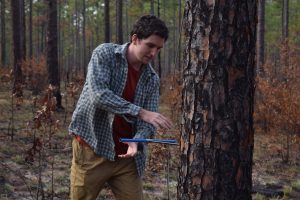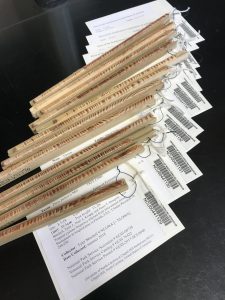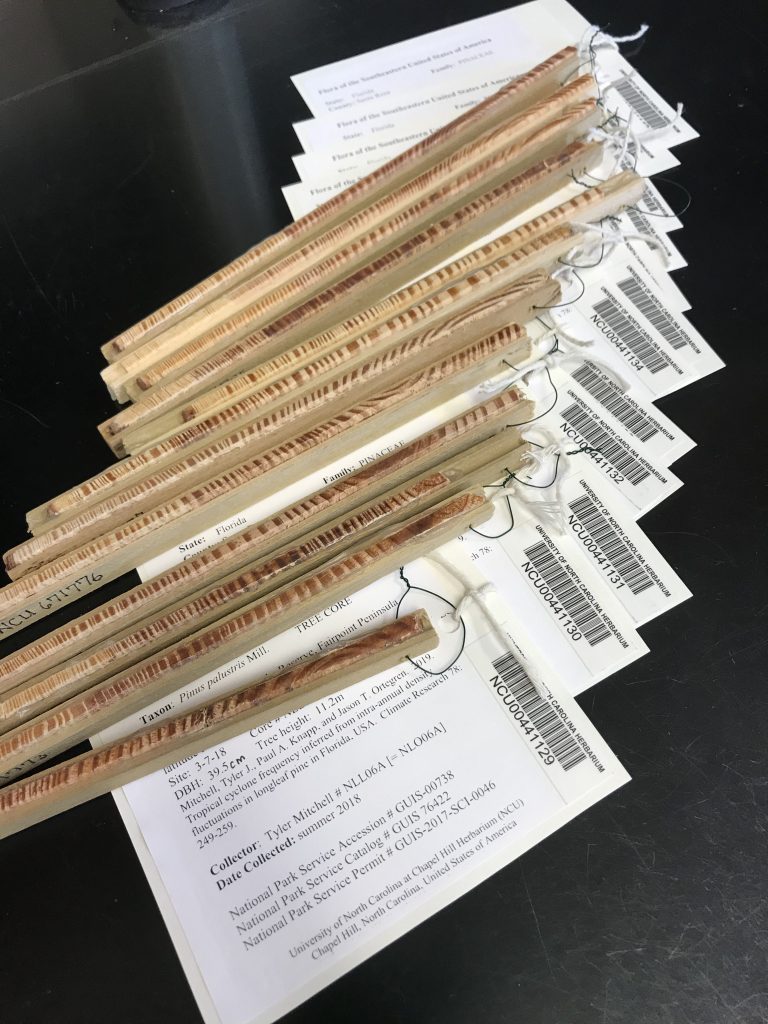By Carol Ann McCormick, Curator, UNC Herbarium
In January, I got a phone call asking if the University of North Carolina at Chapel Hill Herbarium (NCU) could curate tree cores collected from the Gulf Islands National Seashore in Gulf Breeze, Florida. As we have never had tree cores in our collection, I asked for more details – what species of tree, who collected them, and most importantly, how big were the cores? Would they fit in standard herbarium cases?

Gulf Islands National Seashore staff referred me to the scientist who collected the tree cores, UNC-Greensboro (UNCG) graduate student Tyler Mitchell. He had collected the trees cores from longleaf pines on the property in summer 2018 as part of his research on climate in the southeastern United States. He assured me that the cores were of modest size, less than a foot long, so they would easily fit in an herbarium case. Since UNCG does not have an herbarium, and we already curate botanical specimens from Gulf Islands National Seashore, we were the logical place to deposit the cores.
On February 4, I drove to Greensboro to fetch the tree cores and to tour the Carolina Tree-Ring Science Laboratory at UNCG, where Mitchell studies under Dr. Paul Knapp. Their research focuses on the influence of atmospheric CO2 on the growth rates of woody species in arid environments and the climate history of the Pacific Northwest.1 However, they also have ongoing research projects in the southeastern US, including in the Uwharrie Mountains, the Sandhills, and the Outer Coastal Plain of North Carolina.2
Mitchell’s research uses tree cores to reconstruct historical tropical cyclone frequency to try to understand hurricane activity before historical records. Mitchell uses longleaf pines (Pinus palustris Mill.) because they are long-lived (> 400 years) and grow in hurricane-affected areas.3

Getting the longleaf pine cores accessioned into the Herbarium was a team effort. Using Mitchell’s original data sheets, I made labels containing each tree’s location (latitude/longitude), height, diameter, date, and NCU and National Park Service catalog numbers. NCBG horticultural technician Matt Daley drilled a tiny hole in each tray holding the cores so the identifying label could be tied to the core. Herbarium assistant Greg Sollom made digital images of each core and its label for the online catalog of herbarium specimens, sernecportal.org.
These tree cores have joined our existing collection of specimens from the Gulf Islands National Seashore, dating back 128 years. These include finger rot (Cnidoscolus stimulosus), squareflower (Paronychia erecta), scarlet calamint (Clinopodium coccineum), sand heath (Ceratiola ericoides), and bayhops (Ipomoea pes-caprae). Tyler Mitchell’s fifty-two Longleaf pine tree cores are just the latest in the botanical legacy of the Gulf Coast barrier islands preserved by the National Park Service and the University of North Carolina at Chapel Hill Herbarium.
- Dr. Paul Knapp, accessed on 18 February 2020. https://ges.uncg.edu/person/knapp/
- Thomas W. Patterson, Lindsay W. Cummings, and Paul A. Knapp(2016) Longleaf Pine (Pinus palustris Mill.) Morphology and Climate/Growth Responses Along a Physiographic Gradient in North Carolina, The Professional Geographer, 68:2, 238-248, DOI: 10.1080/00330124.2015.1059404
- Mitchell, Tyler J., Paul A. Knapp, and Jason T. Ortegren (2019) Tropical cyclone frequency inferred from intra-annual density fluctuations in longleaf pine in Florida, USA. Climate Research 78: 249-259. https://doi.org/10.3354/cr01573
